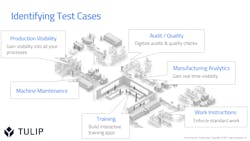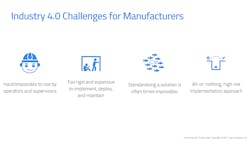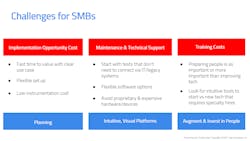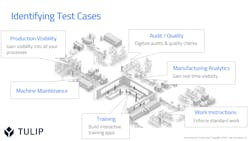Static Manufacturing Can’t Exist in a Dynamic World, Part 1
As you read this, an incredibly complex set of interdependent systems hum ceaselessly behind the scenes. We all depend on these systems’ continuous operation for many of our most basic needs, yet we seldom give them a second thought. The clothes on our back, everything in our offices and homes, the computer on which these words were written, or the screen on which they are being read...It sounds obvious, but if you take the time to consider it it’s sure to give you pause. Someone, somewhere made literally everything that we rely on in our daily lives.
Who makes this stuff and how do they make it? What systems are in place that enable continuous production despite the incredible volatility within which these systems exist—political uncertainty, market shocks, shifting competitive advantages. Manufacturing operations must be robust enough to withstand external shocks, yet they must also be optimally efficient to outcompete increasingly diverse challengers from around the world.
A look inside of the modern manufacturing machine reveals a system bringing together hundreds, sometimes thousands, of individual contributors while tying into automated machines and control systems. We see that the rate of change is faster than ever, and still accelerating—ushered in by an era of new technology. Tomorrow’s victors will be those who can understand and take advantage of this change; yet, surprisingly few tools are available to help make sense of the chaos. Today technology offers a new layer of software that simplifies operations, connects data silos, and enables feedback loops across manual and automated manufacturing lines.
How Many Variables Can We Solve For?
At the end of the day, most manufacturers care about one thing. How can they increase the number of widgets they can produce per resource consumed. Successful manufacturing operations will reliably produce more and better than their competitors while consuming fewer resources. It is the role of industrial, process, and quality engineers to improve, control, and predict this ratio of production and resources. The sole goal of the manufacturing operation is to optimize the value chain. The fundamental resources available to them are process design, training, and strategic investment in enabling technology.
Historically, manufacturing was viewed a relatively static system. Process or industrial engineers would attempt to determine the various inputs to the system and solve for the optimally efficient process. Consider the modern assembly line. The key insight behind it was in balancing resources evenly over a particular segment of the value chain. The assembly line allowed for maximum throughput while minimizing the possibility of human error by narrowing the scope of human engagement, and allowing for increased specialization. Each worker did more, faster, and better, while simultaneously requiring less training.
The assembly line notion of manufacturing works well when the inputs and demands of the system are both static and knowable; however, as this methodology suffuses throughout the manufacturing value chain, interdependencies quickly emerge between the various systems. The availability of inventory impacts the rate at which the assembly line can produce. The rate at which finished product can be shipped, impacts how much of the total available resources should be dedicated to the assembly operation versus logistics, or the procurement divisions of the enterprise. Trying to solve for the optimal system, one had to first track and understand the various inputs and demands of the static system. In this era, the operations that won were those had the best conceived and executed systems in place.
Technology Begets Capabilities Beget Capability
The introduction of new technology increased the options available to the manufacturer. With each new technology introduced into the static system, one saw an exponential increased the total number of possible combinations that had to be considered to solve for the optimal design. In this context it becomes more difficult for process engineers to conceptualize the system of operations and the associated interdependencies. As a result, the unified system that was the manufacturing value chain was fragmented into various subsystems and relegated to a diverse set of stakeholders—each tasked with optimizing their small piece but each possessing only a limited view over how it impacted the whole.
In the Dynamic System, Flexibility Reigns
To further confound matters, the static view of the manufacturing system only works when we consider a relatively stable high-volume, low-mix operation. In reality, manufacturing operations must accommodate both the occasional shocks to the system and shifting consumer demands. Today’s product line will not run indefinitely. Products, and the systems that build them are constantly adapting. There is no static optimal state of the interrelated manufacturing subsystems. Rather, it is a constantly shifting target that manufacturers continuously seek.
It was in this context in the early 1990s that a particular philosophy emerged from an auto manufacturer in Japan. Toyota was the first to realize that the manufacturing problem couldn’t be solved by treating the operations as a static system with a single optimum. Rather, Toyota treated the operation as a dynamic system whose optimal state could never be achieved but must be continuously sought. To do this, the automaker identified various data points which were leading indicators of quality and production. By monitoring and seeking to continuously improve upon these key performance indicators (KPIs), one could move the system toward its ever shifting optimally efficient state. Whenever inefficiency was identified, steps were taken to eliminate it. The work is never finished. Efforts to learn more and improve the system according to the identified KPIs were continuous.
This philosophy was described as “lean” manufacturing and it is now common practice among most virtually all competitive major manufacturers. Leading consulting firms like McKinsey and the Boston Consulting Group regularly partner with market leaders to help them instill the lean philosophy in their operations.
Despite the flurry of technological innovation introduced to manufacturing, the tools leveraged by market leaders to identify, monitor, and continuously improve their manufacturing operations remain largely unchanged. A visit to any leading manufacturing shop floor will reveal paper forms being used to track defects, manual stopwatches to try to gauge the cycle time to complete the various steps in a manual assembly line, manual counters that are clicked when a product fails the quality inspection, and whiteboards used to track daily output targets and first past yield. These manual means of providing feedback loops are time intensive and error prone, yet they are consistently encountered in many of the most technologically advanced operations on the world, some of which produce the very technologies that render paper forms obsolete in other environments.
What About Software?
Computers and the internet era have forever changed how we think about the flow of information. Both incumbents and newcomers to the industrial software space have sought to create solutions to the problems described thus far. Yet, the user-friendly interface of the modern web to which we have become so accustomed is conspicuously absent in the manufacturing environment. Manufacturers still rely on pre-internet tech such as paper-based forms, manual time studies, and whiteboards to manage the flow of information on the shop floor. It’s worth spending a moment to consider the software solutions made available to date and why they fail to answer the demands encountered on the shop floor.
The need for a layer of connective tissue on the shop floor is not a novel concept. The generic name attributed to this layer of tech is a Manufacturing Execution System, or simply an MES. At a high level, the MES is designed to track the items through the manufacturing value chain from raw inventory to the finished product. The MES system is complementary to a separate system called the enterprise resource planning system, or ERP. The ERP handles back office tasks such as tracking raw inventory, orders, and product shipped.
If the ERP tells manufacturers what goes where, the MES tracks how, when, and who builds it. The MES is supposed to fill the communication gap between the ERP and the control system to run equipment on the plant floor. It is designed to coordinate functions on the shop floor to optimize the planned production activities. The MES’s core function is to manage material production tracking, handle production procedures, and collect data for each of these activities. Additionally, a number of extensions are typically available in an MES system such as, compliance, quality assurance, and performance analysis.
A slew of both incumbents and newcomers can be found offering MES software systems to manufacturers. software vendors all make similar claims about the advantages of their solutions. They claim their software will reduce manufacturing cycle times, reduce work in progress, reduce or eliminate shift turnover discontinuity, reduce lead time, improve quality, and empower plant operations workers. Yet, visit some of the shop floors where these systems are deployed and one will still find that paper forms, clipboards, stopwatches, whiteboards, and clickers are still the tools of choice for the front line engineers responsible for keeping the operation moving and meeting production targets.
Despite the promises of the existing software solutions, it shares some common attributes from manual tracking that render technology incapable of addressing the fundamental needs encountered on the shop floor. Some of the problems are:
- Some technology is expensive
- It has poor user interfaces and HMIs
- It is built custom by a third-party integrator for each unique operation
These systems are centrally administered and inherently inflexible. It can takes hundreds, sometimes thousands, of hours to design and completely roll out an MES for a large manufacturer. A host of third-party integrators then exist to survey the specific needs of the operation and then customize the MES to accommodate these needs. Any changes have to be directed from the front-line engineers through IT to the one or two third-party integrators with the knowledge and charter to make the required adjustments.
The fundamental disconnect between the promises of the modern MES and the needs of today’s shop floor is that today’s software solutions betray a static view of the operation at the center of their design. They seek to understand and build to an optimized state of the manufacturing operation and then enable that system’s continuous operation. However, as has been discussed, the needs in the modern manufacturing environment are dynamic in nature. Manufacturers are dealing with constantly changing inputs and demands. The only way to manage such variability is to embrace flexibility and continuous improvement at the very core of the operation. The software must also embrace this need for flexibility as a core principle of design.
Conclusion
Today’s manufacturing operations exists within a dynamic environment with constantly shifting inputs and deliverables. Increasingly manufacturing is moving toward high mix low volume production and built-to-order supply chains. Existing software systems fail to meet the demands of the modern manufacturing environment because they are custom-designed to optimize a static system and are inherently inflexible.
In Part 2 of this series we present common challenges across different industries, how tech enables us to manage complexity, and what is needed in the tools of tomorrow.
Erik Mirandette is head of customer operations at Tulip.





